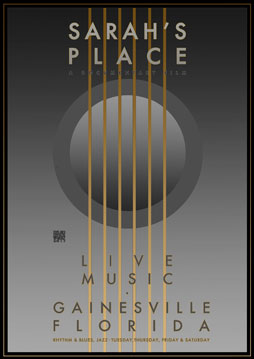
Click on image for detail
(244) Sarah's Place:
(244) Sarah's Place: Edition of 1459 of which 125 are signed 1-125 and 27 are signed A-Zz as Artist's Proofs. Three signed sets of progressives.
August 21, 2017
17-3/8" x 24"
Six colors
Paper: Finch Fine Cover Ultra-smooth 100 lb. cover
Client:
1-125: Saint Hieronymus Press
A-Zz: Artist's own use
Progressives: Harold Fethe
Dedication copies: Nat Adderley, Jr., Harold Fethe, Ron Gause, David & HiJib Hodge, Bobby McKnight, Sonny (Charles Jr) McKnight, Longineu Parsons, Denis Pellerin, Tim Robinson, Jon Shirley, Charles Steadham, Earl W.Wallace, Larry Willis, Jimmy Young
"Jazz," Stanley Crouch writes, "predicted the civil rights movement more than any other art in America." *
Of white jazz clarinetist Mezz Mezzrow, Eddie Condon said. "When he fell through the Mason-Dixon line he just kept going." Clarinetist Benny Goodman was responsible for a significant step in racial integration in America. In the early 1930s, black and white musicians could not play together in most Northern clubs, and not at all in the South. Goodman broke with tradition by hiring black pianist Teddy Wilson to play with him and the white drummer Gene Krupa in the Benny Goodman Trio. In 1936, he added black vibraphonist Lionel Hampton to form the Benny Goodman Quartet. Goodman was popular enough that he could make a living without touring the South, where he would have been subject to arrest for violating Jim Crow laws.
In the late 1950's and early 1960's, Sarah McKnight ran the Cotton Club and Sarah's Place in Gainesville Florida, where Jim Crow laws were embedded in the state constitution. Despite the illegality, and considerable danger, white musicians like saxophonist Charlie Steadham and guitarist Harold Fethe wanted to learn and play with the best - Cab Calloway, B.B. King and James Brown - and this brought them to Sarah's Place.
Desegregated entertainment during the Civil Rights era was about more than music: it was about black music moving into the mainstream; about black and white musicians playing to integrated audiences; about the power of music to bring people together whatever their race, religion or politics might be. It took a lot of courage, to risk your life to make music. Just the kind of courage we may need again.
People, get ready.
*Obama's One Cat Who Needs to Put Jazz on His Party Menu—Stanley Crouch, Daily News, December 21, 2005